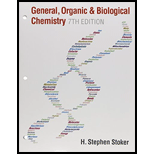
Interpretation:
Nitrogen, oxygen, and carbon atoms have to be contrasted based on the number of nonbonding electron pairs that is present in organic compounds.
Concept Introduction:
Organic compounds are the important basis of life. They include gasoline, coal, dyes, and clothing fibers etc. The compounds that are obtained from living organisms are termed as organic compounds and those obtained from the earth are known as inorganic compounds. Organic compounds are found in earth also apart from living organisms. All the organic compounds contain the element carbon. Urea was synthesized in the laboratory which is an organic compound.
The number of bonds an atom forms with other atoms depends upon the ability to attain the stable octet configuration of electrons.
Nonbonding pair of electrons is the ones that are not involved in covalent bonding. It is an unshared pair of electrons. These are present as lone pairs.
Trending nowThis is a popular solution!

Chapter 17 Solutions
Bundle: General, Organic, and Biological Chemistry, 7th + OWLv2 Quick Prep for General Chemistry, 4 terms (24 months) Printed Access Card
- What characteristics of carbon make it ideal for the formation of organic compounds?arrow_forwardIndicate whether or not each of the following covalent bonding behaviors are possible for an oxygen atom in an organic compound. a. One single bond b. Two single bonds c. One double bond d. Two double bondsarrow_forwardThis molecule belongs to which class of organic compounds? CH3⎯CH2⎯O⎯CH3 carboxylic acid alcohol aldehyde ether esterarrow_forward
- What are the solubility properties of organic compounds?arrow_forwardWhich of the following statements correctly describes the typical number of bonds for carbon, nitrogen, and oxygen in most neutral organic molecules?arrow_forward1. identify the non-covalent structural effects of organic compounds.arrow_forward
- Many substitution reactions are initiated by electrostatic attraction between reactants. Show where this attraction arises in the formation of an amide from an amine and an ester.arrow_forwardOrganic compounds have predictable chemical and physical properties determined by their respective structures. Rank the following molecules with similar numbers of carbons in terms of their boiling points ethanoic acid, ethanamine, methoxymethane, ethane, ethanamide. Explain why you expect these differences. Predict which molecule would be liquid at room temperature.arrow_forwardGive a definition and an example for each class of organic compounds.(1) aldehyde (2) aromatic hydrocarbon (3) carboxylic acid(4) ester (5) amine (6) amide(7) nitrilearrow_forward
- Give simple chemical tests to distinguish between the following pairs of compounds. isopropyl alcohol and tert-butyl alcohol methylamine and acetic acidarrow_forwardExplain the importance of carbon in the large, complex structures of organic compounds. In your answer, describe at least four of carbon's properties.arrow_forwardTrue or false The carboxyl group has the same properties as alcohols and aldehydes. Carboxylic acids have lesser hydrogen bonds relative to aldehydes. Carboxylic acids are carbonyl compounds.arrow_forward
 General, Organic, and Biological ChemistryChemistryISBN:9781285853918Author:H. Stephen StokerPublisher:Cengage Learning
General, Organic, and Biological ChemistryChemistryISBN:9781285853918Author:H. Stephen StokerPublisher:Cengage Learning Organic And Biological ChemistryChemistryISBN:9781305081079Author:STOKER, H. Stephen (howard Stephen)Publisher:Cengage Learning,Chemistry: Matter and ChangeChemistryISBN:9780078746376Author:Dinah Zike, Laurel Dingrando, Nicholas Hainen, Cheryl WistromPublisher:Glencoe/McGraw-Hill School Pub Co
Organic And Biological ChemistryChemistryISBN:9781305081079Author:STOKER, H. Stephen (howard Stephen)Publisher:Cengage Learning,Chemistry: Matter and ChangeChemistryISBN:9780078746376Author:Dinah Zike, Laurel Dingrando, Nicholas Hainen, Cheryl WistromPublisher:Glencoe/McGraw-Hill School Pub Co Chemistry & Chemical ReactivityChemistryISBN:9781337399074Author:John C. Kotz, Paul M. Treichel, John Townsend, David TreichelPublisher:Cengage Learning
Chemistry & Chemical ReactivityChemistryISBN:9781337399074Author:John C. Kotz, Paul M. Treichel, John Townsend, David TreichelPublisher:Cengage Learning Chemistry & Chemical ReactivityChemistryISBN:9781133949640Author:John C. Kotz, Paul M. Treichel, John Townsend, David TreichelPublisher:Cengage Learning
Chemistry & Chemical ReactivityChemistryISBN:9781133949640Author:John C. Kotz, Paul M. Treichel, John Townsend, David TreichelPublisher:Cengage Learning Chemistry: The Molecular ScienceChemistryISBN:9781285199047Author:John W. Moore, Conrad L. StanitskiPublisher:Cengage Learning
Chemistry: The Molecular ScienceChemistryISBN:9781285199047Author:John W. Moore, Conrad L. StanitskiPublisher:Cengage Learning





